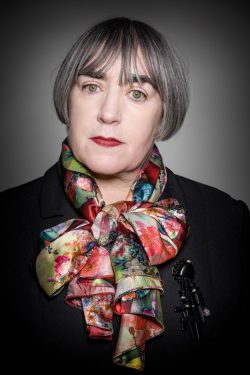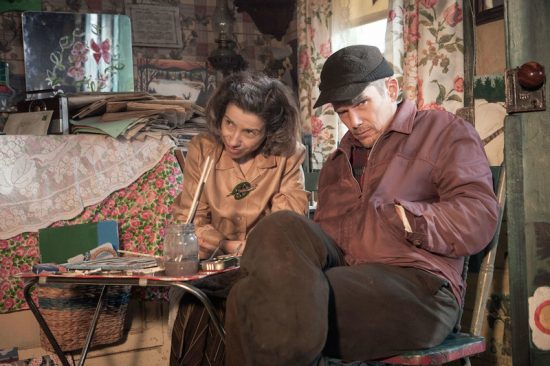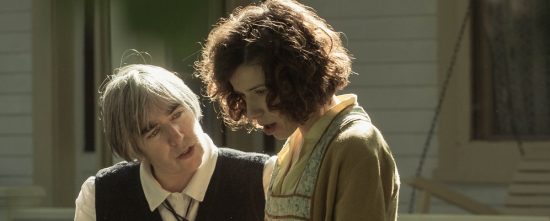In conversation with Maudie’s director Aisling Walsh – Live For Films
One of this year’s cinematic surprises, Maudie is one of those thematically rich indie dramas poised to move, inspire and offer food for thought long after credits roll. You can read my full review here.
The true but little known story of Canadian folk painter Maude Lewis is an astounding portrait of an incredible woman who, in spite of being plagued with physical suffering since tender age, strived and thrived to live life the way she wanted – finding love in unexpected places and letting her artistic passion fuel every day of her life.
Showcasing two amazing performances by Sally Hawkins and Ethan Hawke, both worthy of awards-season love, Maudie is undoubtedly one of this year’s best films as illustrated in our five-star review. We had the pleasure to meet up with filmmaker Aisling Walsh upon the film’s release in London and delved into why she fell in love with Maud’s story, the challenges of crafting such a unique and intimate portrait of a real person and the meaning of true artistic passion.
—
What made you connect with Maud Lewis and her story?
For starters, I was trained as a painter so I’ve been really interested in women artists and how little known they are. I came across the story of an another artist I was really interested in making into a film but then Maudie’s script came along. I read it at once in a hotel room in Cardiff and I thought it was incredible. I’d never heard of her so I got online and looked at her work, which was striking and different. The second thing that really appealed to me was that it’s a portrait of her relationship with Emmett across forty years and how these two people lived that life together and survived in that little house and that was fascinating too. To make such an intimate film was an interesting challenge. If somebody had asked me to make it ten-fifteen years ago I’d have probably run for the hills but now that detailed storytelling is the kind of challenge I’m interested in.
I also thought it was an amazing opportunity to work with two actors as obviously it was a character piece that would rely heavily on performance and in that respect it felt rather unique. I immediately thought of Sally for the role because we loved working together in the past and we had both been meaning to find a new project to collaborate on. After being stuck in development for over 10 years it seemed like the stars were aligning. I really believe that especially for these small, independent films the combination of the right people is everything. Ethan was busy at first, then both him and Sally got nominated for an Oscar that year which took a up a lot of their time. Sally was exhausted traveling around so we waited for her another year and in the end, by the time both actors were available, the weather in Newfoundland (a Canadian island) where we shot the film was the ideal one for filming.
Did you ever think of casting another pair of actors for the later years in the lives of Maud and Everett?
When I joined the project there was that discussion but I said no. I don’t know how I would’ve done that and I simply wouldn’t have bought into more than one actor. Fortunately, not long before Maudie I tackled the same issue on a film I did for BCC about Welsh poet Dylan Thomas to celebrate his centenary. They thought they needed two actors but I convinced them that the audience had to buy into one person. In the end, ageing over the course of 30-40 years is really demanding and challenging for an actor but also exciting to do.
When we show the archive footage of the real-life Maud and Everett at the end of the film, viewers will notice that the actors don’t look quite like them but the essence of what they have portrayed makes up for any lack of resemblance. It’s different if you have to portray a character as a child or teenager and then as an adult but when you’re capturing an age shift within adulthood, you can get away with the same actor and frankly both these Sally and Ethan can play younger. Of course, you do tests with the makeup department and find the right balance in the ageing process.
Were there any other production challenges, especially location-wise?
The house, of course, was the main one. When I came on board we talked a lot about building it in a studio but then, when I was in one of those vast studio stages, walking around and gaging various measurements, it felt too artificial to shoot in there. I understand why they were considering it since the weather in Newfoundland is brutal – from horizontal rain and hurricanes to snow – but we found a way to do it and that was one of the best decisions made on the film because it changed everything. It was real for everybody but especially for Sally and Ethan, it was a unique experience to actually feel like they were living in an authentic environment.
What did you see in Maud and Everett’s relationship that drew you to the project as you were mentioning before?
If Maud’s parents hadn’t died prematurely, I think her life would’ve been very different. She was very well brought up and well educated despite eventually being home schooled due to other kids taunting her for the physical impairments. Then her brother disinherited her and she went to live with this aunt where she was conducting a bleak life. She obviously realised that there was something more to life. That something else she wanted at that point was never Everett but when she found his ad for a housekeeper she saw an opportunity to get away from the life she didn’t want. At the beginning, they clash and you’d never think they’re meant to fall in love. He’s very silent and closed off, used to living on his own and she starts to take up his space and it’s really interesting to see their relationship change.
I think viewers are meant to recognise something from their own lives in that relationship such as how hard it is to live with somebody else or how you can live with very little if you’re with the right person. In the end, he looked after her, whereas at the beginning she’s looking after him. She was able to paint and be creative and wound up painting almost every inch of that house and he went along with it cause he found company and someone he could relate to. It took him a while but he did relate to her. They didn’t speak much, they were mostly living in silence, tending to their own things but taking care of each other and that’s how most people’s lives are. It sometimes takes you a while to realise that’s the person you’re going to be with for the rest of your life. In those times, the 1930s and 40s life was very different and much tougher in many ways. You could live in an isolated way that would probably be difficult to do now with no phone, television or radio. Yet despite this lack of communication they went on and lived their lives and it was mostly about survival out there, how to live day to day, get wood for the fire, make sure they could feed themselves. That’s also the unique thing about their story.
One of the most interesting themes of the story is how this woman managed to nurture her passion for art without caring about a career or money. She lived a simple life doing what she loved and that was all she needed. Do you think such fulfilment in life is truly achievable nowadays?
Yes, I do. Of course, she sold her art so that kept her going whilst he earned a bit of money with whatever work he did. I think if your passion is art then you’ve just got to do it really, whether you make money or not whilst doing some something else on the side that enables you to keep making art. As a young filmmaker, I did lots of other things so I could carry on making films and developing projects so I think people still do that. In some respect, it’s easier to do nowadays because of technology. You can make a film with your iPhone and there’s a lot of material that’s available on the Internet. In the end, though, I believe it comes back to having that passion to do it.
She was really fortunate that she was able to paint every day since not many people can do that. But there was a price to pay: she was living in a 12×12 foot house with no running water and electricity for 40 years, not going on holidays. That was their life. I think her work is full of that passion. She had great positivity and in fact, her paintings had no shadows cause she never painted the darkness in her life but only beauty and the good things, despite surely having days where she must have struggled to paint and survive in that brutal weather and with her health issues. Yet she and Everett had an amazing relationship and I think they were both very lucky to meet one another. That’s what the film is about: it makes you examine your own life and relationships and realise you actually have a lot to be happy and thankful for.













